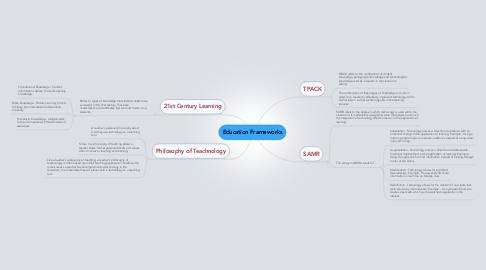
1. 21st Century Learning
1.1. Refers to types of knowledge that students need to be successful in the 21st century. These are characteristics and attributes that we must foster in our students.
1.1.1. Foundational Knowledge - Content, Information Literacy, Cross-disciplinary knowledge.
1.1.2. Meta Knowledge - Problem solving, Critical thinking, Communication/Collaboration, Creativity.
1.1.3. Humanistic Knowledge - Life/Job skills, Cultural competence, Ethical/Emotional awareness.
2. Philosophy of Teachnology
2.1. A teacher's personal philosophy about how they use technology as a teaching tool.
2.2. Similar to a philosophy of teaching where a teacher states his/her personal beliefs and values when it comes to teaching and learning.
2.3. Like a teacher's philosophy of teaching, a teacher's philosophy of teachnology is often based upon their teaching experience. Therefore, the more success a teacher has had implementing technology in the classroom, the more likely they will place value in technology as a teaching tool.
3. TPACK
3.1. TPACK refers to the combination of content knowledge, pedagogical knowledge and technological knowledge used by a teacher in the classroom setting.
3.2. The combination of these types of knowledge is crucial in order for a teacher to effectively implement technology within his/her lesson so that technology aids in the learning process.
4. SAMR
4.1. SAMR refers to the degree in which technology is used within the classroom. It is effectively a weighting scale that judges how much the integration of technology affects a lesson or the application of learning.
4.2. The acronym SAMR stands for...
4.2.1. Substitution - Technology acts as a direct tool substitute, with no functional change to the application of learning. Example - Using a ruler on google maps to measure a distance instead of using a real ruler and a map.
4.2.2. Augmentation - Technology acts as a direct tool substitute with functional improvement to the application of learning. Example - Using Google search to find information instead of looking through books at the library.
4.2.3. Modification - Technology allows for significant task redesign. Example - Having students share information in real time on Google docs.
4.2.4. Redefinition - Technology allows for the creation of new tasks that were previously inconceivable. Example - Using Screen Chomp to create screencasts which can be watched repeatedly on the internet.
